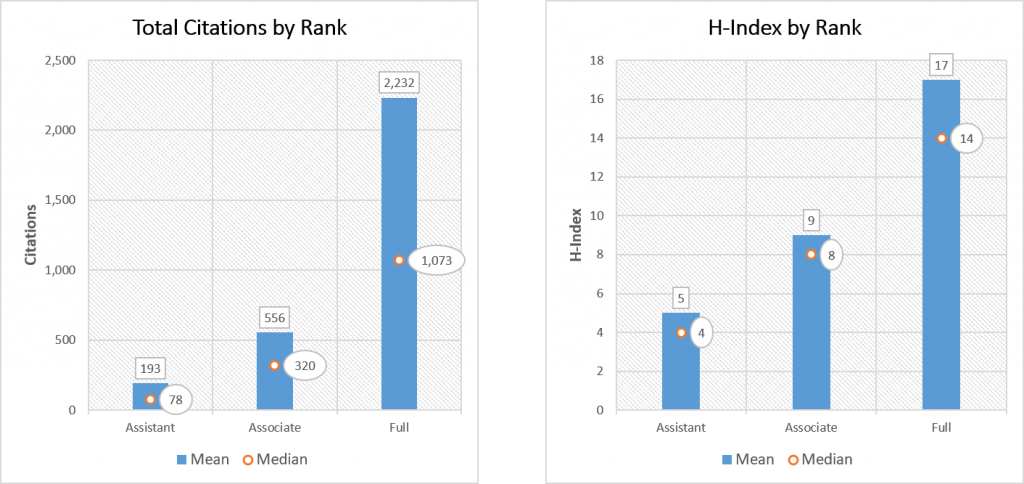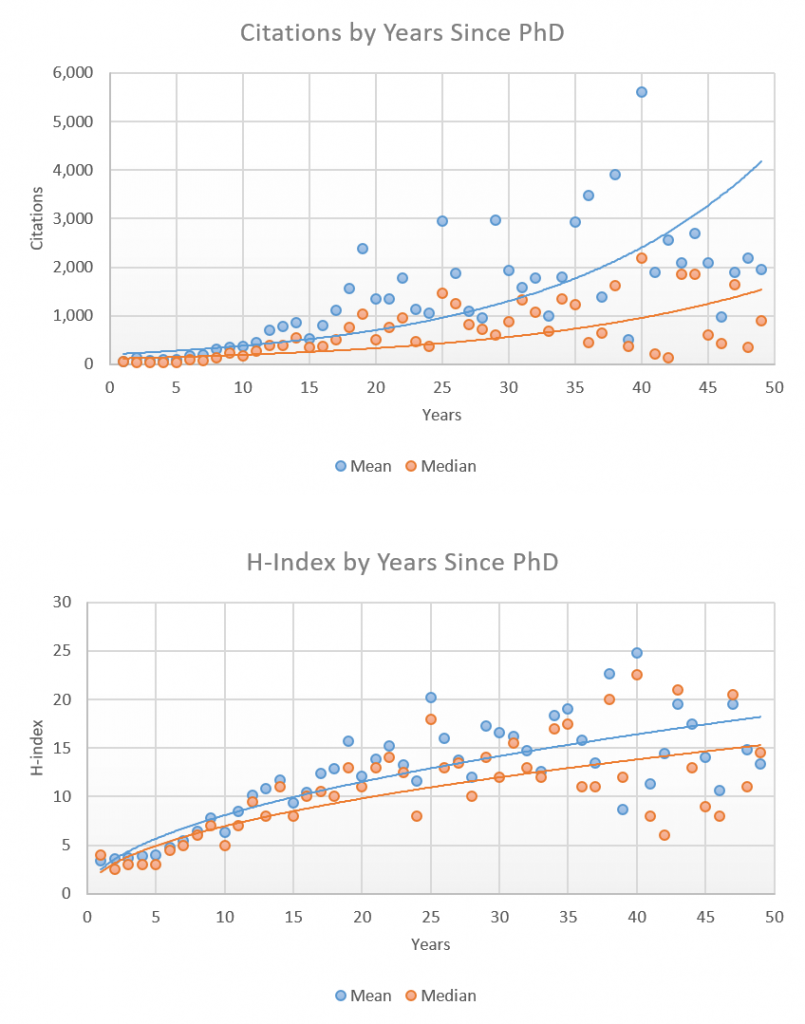Approximately half of urban planning faculty in the U.S. and Canada now have Google Scholar Profiles (534 out of 1,079), which makes my data collection a bit easier now than in the past. I tabulate publication and citation activity manually for individual faculty who do not have profiles. Not only do profiles help to analyze citation activity, but they also identify publications so that topics and trends can be analyzed. This assumes faculty maintain accurate profiles, which is generally true.
Each year I update faculty rosters from planning program websites, and attempt to include only “regular” (tenure track faculty) faculty at the rank of Assistant Professor, Associate Professor, and (Full) Professor. The objective is to represent faculty who are full-time members of these programs – not an easy task given the wide range of faculty appointments and affiliations. Instead of rehashing the whole methodology here, see my article in the Journal of Planning Education and Research (JPER). The following shows the most cited individuals and planning programs. Also shown are statistics by rank, years since terminal degree, and gender. Previous year results are available for 2017, 2016, 2015, 2014, and 2013. In addition, the full, searchable database is available here.
Table 1. Top 25 Urban Planning Faculty Ranked by Google Scholar Citations
| Rank | Name | School | Citations |
|---|---|---|---|
| 1 | Michael Storper | UCLA | 36,968 |
| 2 | AnnaLee Saxenian | UC Berkeley | 25,608 |
| 3 | Neil Brenner | Harvard University | 25,089 |
| 4 | Lawrence D. Frank | University of British Columbia | 24,469 |
| 5 | Stewart Fotheringham | Arizona State University | 19,111 |
| 6 | Reid Ewing | University of Utah | 18,899 |
| 7 | Martha Feldman | UC Irvine | 17,765 |
| 8 | John M. Bryson | University of Minnesota | 15,664 |
| 9 | John Forester | Cornell University | 14,598 |
| 10 | Nik Theodore | University of Illinois, Chicago | 14.149 |
| 11 | Robert Bullard | Texas Southern University | 13,273 |
| 12 | John Pomeroy | University of Saskatchewan | 11,802 |
| 13 | Jennifer Wolch | UC Berkeley | 10,526 |
| 14 | Julian Agyeman | Tufts University | 9,492 |
| 15 | Lawrence Susskind | MIT | 8,941 |
| 16 | Dale Whittington | UNC | 8,768 |
| 17 | Marina Alberti | University of Washington | 8,705 |
| 18 | Marlon Boarnet | USC | 8,701 |
| 19 | Teresa Caldeira | UC Berkeley | 8,551 |
| 20 | Susanna B. Hecht | UCLA | 8,207 |
| 21 | Rob Shields | University of Alberta | 8,032 |
| 22 | William N. Dunn | University of Pittsburgh | 7,926 |
| 23 | Genevieve Giuliano | USC | 7,791 |
| 24 | Daniel Rodriguez | UC Berkeley | 7.485 |
| 25 | Timothy Beatley | University of Virginia | 7,436 |
Table 2. Top 25 Urban Planning Programs Ranked by Median Google Scholar Citations
| Rank | Planning School | Faculty | Total | Median | Mean |
|---|---|---|---|---|---|
| 1 | Columbia University | 7 | 15,741 | 2,366 | 2,248 |
| 2 | UCLA | 24 | 100,198 | 2,287 | 4,174 |
| 3 | New York University | 6 | 11,793 | 1,945 | 1,965 |
| 4 | USC | 15 | 38,144 | 1,706 | 2,542 |
| 5 | Simon Fraser University | 15 | 37,672 | 1,658 | 2,511 |
| 6 | Arizona State University | 13 | 35,502 | 1,532 | 2,730 |
| 7 | Rutgers University | 15 | 22,045 | 1,478 | 1,469 |
| 8 | University of Minnesota | 12 | 38,113 | 1,417 | 3,176 |
| 9 | UC Berkeley | 15 | 69,754 | 1,331 | 4,650 |
| 10 | University of Maryland | 8 | 11,747 | 1,291 | 1,468 |
| 11 | UNC | 15 | 31,591 | 1,288 | 2,106 |
| 12 | MIT | 26 | 51,953 | 1,079 | 1,998 |
| 13 | Tufts University | 6 | 18,952 | 1,031 | 3,158 |
| 14 | The New School for Social Research | 7 | 7,136 | 1,013 | 1,019 |
| 15 | Harvard University | 17 | 47,091 | 979 | 2,770 |
| 16 | University of Toronto | 19 | 17,218 | 928 | 906 |
| 17 | University of Saskatchewan | 12 | 24,862 | 860 | 2,071 |
| 18 | University of Pittsburgh | 5 | 9,715 | 791 | 1,943 |
| 19 | University of Alberta | 13 | 17,773 | 787 | 1,367 |
| 20 | University of Michigan | 22 | 27,865 | 738 | 1,266 |
| 21 | Georgia Tech | 13 | 13,865 | 690 | 1,066 |
| 22 | University of Pennsylvania | 12 | 19,050 | 688 | 1,587 |
| 23 | University of Massachusetts-Amherst | 6 | 3,570 | 662 | 595 |
| 24 | Wayne State University | 4 | 4,224 | 633 | 1,056 |
| 25 | University at Buffalo, The State University of New York | 15 | 8,509 | 632 | 567 |
Figure 1 & 2. Citations and H-Index by Rank
Figure 3 & 4. Citations and H-Index by Years
Figure 5. Citations and H-Index by Gender
Finally, the planning faculty included here currently account for over 1.2 million citations. This total includes double-counting that result from co-authored publications by planning faculty. By far the most cited publication is AnnaLee Saxenian’s book Regional Advantage, published in 1996. The top cited journal article is Julian Agyeman’s “Mind the Gap: Why do people act environmentally and what are the barriers to pro-environmental behavior?” in Environmental Education Research (co-authored with Anja Kollmuss). See the top 25 cited publications in Table 3.
Table 3. Top 25 Cited Publications by Planning Faculty
More analysis is underway, stay tuned. Your comments are greatly appreciated. Please report any errors or omissions to: tom.sanchez@vt.edu.




insightful analysis, is there anything similar for across the Atlantic? 🙂
I’d like to do this at some point. I’ll check into it.
Pingback: Citation Activity of Urban Planning Assistant Professors | Tom Sanchez
Pingback: Yes, h-index and total citations are highly correlated (in case you were wondering) | Tom Sanchez